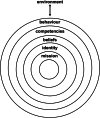Development of a questionnaire to measure teachers' student-centred perspectives based on the Onion Model
- PMID: 35761250
- PMCID: PMC9238174
- DOI: 10.1186/s12909-022-03547-9
Development of a questionnaire to measure teachers' student-centred perspectives based on the Onion Model
Abstract
Background: Teachers with a teacher-centred perspective have difficulties applying student-centred approaches in Problem Based Learning (PBL) because they are inclined to show teacher-centred behaviours. The six aspects explained in Korthagen's Onion Model (environment, behaviour, competencies, beliefs, identity, and mission) are assumed to contribute to teachers' perspectives, showing that both the environment and personal characteristics influence behaviours. For teachers to function properly in PBL, those six aspects should reflect a student-centred perspective. Previous instruments to measure teaching perspectives focused on only a few of these relevant aspects. Therefore, we developed the Student-Centred Perspective of Teachers (SCPT) questionnaire with subscales for each aspect in the Onion Model. This study aimed to provide evidence for its internal and external validity.
Methods: The SCPT was distributed in a survey to 795 teachers from 20 medical schools. For the internal validation, Confirmatory Factor Analysis was performed to analyse theoretical fit model validation, convergent validation, and discriminant validation. For the external validation, teachers' perspective scores were compared among three groups of amount of PBL training using Analysis of Variance (ANOVA) and post-hoc Least Significant Difference (LSD) tests. The p-value for all tests was set at .05.
Results: A total of 543 out of 795 teachers (68.3%) participated. Confirmatory Factor Analysis showed the evidence of the SCPT's internal validation with acceptable fit for the six subscales measured by 19 items and the following Composite Reliability scores: environment (.72), behaviour (.74), competencies (.63), beliefs (.55), identity (.76), and mission (.60). All items' factors loadings reached a good standard (.5 or greater). Only the environment subscale had the Average Variance Extracted (AVE) score higher than .5 and the Maximum Shared Variance score lower than the AVE score. ANOVA and Post-hoc LSD tests showed that teachers who participated in more PBL training showed significantly higher student-centred perspectives, providing evidence for external validity.
Conclusion: The SCPT is a reliable and valid instrument to measure teaching perspectives. Identifying aspects that do not represent the adoption of a student-centred perspective may provide valuable input for faculty development in the context of PBL.
Keywords: External validation; Internal validation; Onion Model; Problem-based learning; Teachers’ student-centred perspectives.
© 2022. The Author(s).
Conflict of interest statement
The authors declare that they have no competing interests.
Figures



References
-
- Hussain RMR, wan Mamat WH, Salleh N, Saat RM, Harland T. Problem-based learning in Asian universities. Stud High Educ. 2007;32(6):761–72. doi: 10.1080/03075070701685171. - DOI
-
- Kwan CY. PBL in Health Science Education: what is in a name 50 years after inception? J Med Education. 2019;23(3):182–187. doi: 10.6145/jme.201909_23(3).0005. - DOI
MeSH terms
LinkOut - more resources
Full Text Sources

